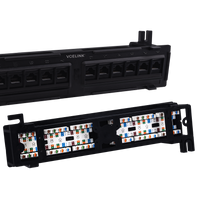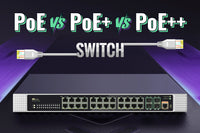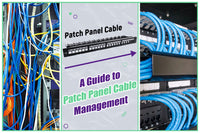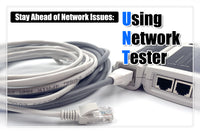A solid, reliable network starts with how you select, install, and maintain your tools, and the Ethernet cable is an essential among them.
Why is it so important to use an Ethernet cable correctly?
An Ethernet cable is a component of the physical layer of the Open Systems Interconnection (OSI) model, which transmits binary data through a physical medium. This layer includes electrical signals, connectors, pinouts, voltages, and data transmission methods. The Ethernet cable serves as the medium that carries these electrical signals.
Even the best Ethernet cable can underperform if you use it incorrectly. If you don’t choose, install, or handle your Ethernet cables properly, some of the consequences you’ll eventually face include:
- A slower internet or network
- A connection that cuts out or disconnects randomly
- An expensive rework, as you may later need to redo the whole setup
In this guide, I explain the 10 mistakes I see most often when people use Ethernet cable, from DIYers pulling a few runs at home to techs wiring complete floors.
For each mistake, we’ll see “why it hurts,” how to fix it, and an expert tip based on real standards (IEEE 802.3, TIA/EIA-568, BICSI, NEC) and best practices.
Join us as we walk through 10 common Ethernet cable mistakes to avoid before you start your next pull.
1. Choosing the Wrong Ethernet Cable Category (Cat5e vs. Cat6/6a/7)
Cable types determine how fast and how far data can travel. Using the wrong one - such as choosing Cat5e for long 10G runs - can cause random slowdowns, while overspending on Cat7 cables for a basic 1G setup will be an unnecessary waste of money. You need to know what each category offers and what the needs of your network are. For example:
- Cat5e: Supports up to 1 Gbps up to 100 meters, viable for most homes.
- Cat6: Handles 1–10 Gbps up to 55 meters, and has better crosstalk resistance.
- Cat6a/7: Designed for 10 Gbps over 100 meters, ideal for future-proofing.
Fix: Check your hardware (e.g., NICs, switches), then pick the lowest category that supports your current and near-future speed needs -such as 2.5G, 5G, 10G. Ensure patch cords, jacks, and panels match the same category to avoid bottlenecks.
Expert Tip: When in doubt, consult the latest IEEE 802.3 standards to verify the different cables’ distances and speeds. Document your category cable choices clearly so no one downgrades the setup later by mistake.
2. Ignoring Bend Radius
Don’t ruin your Ethernet cables with bad bends. If you kink or fold them sharply, this will alter the twist ratio. Stick to the industry rule of thumb: keep bends no tighter than 4× the cable's external diameter (which is usually printed on the jacket). Likewise, avoid over-tightening zip ties as they compress the pairs and change impedance.
The consequences of ignoring the bend radius when you use Ethernet cable include:
- Signal degradation
- Damage to or break of the conductors within the cable
- Reduction of the cable’s lifespan
Fix: Leave some slack in your cable runs, use Velcro instead of zip ties, and avoid sharp 90° bends—especially around patch panels. If you need to turn a corner, use angled fittings or a bend guide to keep a smooth curve.
Expert Tip: If you’re using shielded cables, check the manufacturer’s guidelines. Some have stricter bend limits; follow them and prevent affecting your signal.
3. Running Ethernet Cables Near Power Lines
Keep power and data cables apart. Electromagnetic interference (EMI) from power cables can corrupt the data running through the Ethernet cables and slow your connection, especially if they are unshielded (UTP).
The typical best practices are to:
- Keep at least 12 inches (30 cm) of separation between power and Ethernet cables
- If you must cross them, do it at 90° to minimize coupling.
Fix: During the planning stage, mark the power lines on your floor plan and route data cables separately. If the space is limited, use shielded cable (STP) only as a last resort and ensure to ground it correctly.
Expert Tip: Poorly grounded shielding frequently becomes like a big antenna, making things worse. So if you use STP, make sure grounding is continuous, from the jack to the patch panel to the rack.
4. Skipping Ethernet Cable Certification Tests
The fact that it connects doesn’t mean it’s reliable. Ping only checks if there’s a connection, but doesn’t test the quality of it. Field testers (Fluke DSX, etc.) cost some money, but think of them as worthy investments. They certify the performance of the cable according to strict standards; they test:
- Signal strength
- If there’s interference between wires
- If the cable meets the speed requirements (like for 1G, 2.5G, or 10G)
Using testers before you seal your walls or ceilings, you detect problems early, saving you from the hassle of having to open them later to fix a bad cable run.
Fix: Always certify your cable runs with a field tester. It helps catch bad crimps, loose ends, and low-quality parts before the ceiling gets closed. Save the test reports (in PDF or CSV formats) in your project folder so you can prove everything was done right.
Expert Tip: Label each test file with the exact rack/patch panel/port numbers. When you use Ethernet cable across multiple floors, this will save you hours of guessing where each cable goes.
5. Overstuffing Conduits and Raceways
Stuffing too many cables in one conduit or raceway may seem efficient, as it saves space, reduces material costs, and is faster to install. But in reality, it causes more harm than good. Among the issues that packing an excessive number of cables together can cause are:
- Excess heat buildup (which affects signal quality and cable durability)
- Mechanical stress on the cables (increasing the risk of damage)
- Violation of building codes, such as the National Electrical Code (NEC) Article 800, and BICSI guidelines.
Fix: Calculate the capacity of your conduit and leave around 40% extra space for future upgrades. If you’re already beyond limits, add more pathways or use cable trays or Jhooks to spread the load.
Expert Tip: Use a pull sock; it’s inexpensive and helps avoid tearing cable jackets. If the cable feels stuck while you pull, don’t force it. Stop, reapply lubricant, and pull softly to avoid damaging the internal wire pairs.
6. Terminating Pairs Incorrectly (T568A/B Mix-ups)
Untwisting pairs too far or mixing T568A on one end and T568B on the other silently wrecks signal quality. Messy punch‑downs become problems later.
The problems this creates include:
- More crosstalk and noise because the twists were undone too far away
- Unintended crossover cables that confuse auto-negotiation and fail tests
- Recurrent faults that are consequences of bad punch-downs that take long hours to resolve
Fix: Pick one scheme (A or B) for the whole site and stick to it. Keep the twists up to the punch-down point. Use a good punch-down tool with a sharp blade.
Expert Tip: Color‑code patch panels/keystones or use clearly labeled modules so nobody changes schemes later.
7. Using the Wrong Patch Panels or Jacks
One lower category component drags the whole link down. A Cat6 Ethernet cable terminated on a Cat5e jack becomes a Cat5e.
The following happens when the components don’t match:
- The maximum speed drops down to the lowest-rated component in the chain.
- Cheap or off-spec jacks produce noise, and as a result, the certification fails.
- You can no longer rely on Cat6 or Cat6a performance in real usage.
Fix: Verify that every component (patch panel, jack, even patch cords) matches or exceeds your cable category. Choose brands that publish performance reports.
Expert Tip: If the environment is noisy or you need high-speed, go for “component-rated” gear, so each part and also the entire network are guaranteed.
8. Overlooking PoE Requirements
Power over Ethernet sends current through your data pairs; the more watts, the more heat is produced, especially in tightly bundled cables.
- Ignoring PoE requirements leads to:
- Overheating conductors and exceeding the cable’s temp rating (particularly with IEEE 802.3bt up to 90W)
- Degraded performance and shorter cable lifespan in dense bundles
Fix: If you’re running cables a long way or tying a lot of them together, use thicker wires, make sure air can flow around them, don’t pack too many in one bundle (follow the TSB‑184‑A guideline), and check how much power your PoE switch can actually deliver.
Expert Tip: If you use Ethernet cable for lighting or security cameras, consider a mid-span or dedicated PoE switch to avoid backfeeding sensitive gear and to make maintenance easier.
9. Neglecting Environmental Factors
Pick the wrong cable jacket for the environment, and it will fail soon. A Communications Multipurpose Cable, Riser (CMR), can crack outdoors; in plenum areas, use low-smoke Communications Multipurpose Plenum jackets (CMP). Each setting needs the appropriate rating.
This is likely to happen if you skip the proper ratings:
- Code violations and failed inspections (even possible problems with your insurance company)
- Jackets breaking down due to UV, humidity, chemicals, or abrupt temperature changes
- Chewed, crushed, or abraded cables from rodents, forklifts, or rough surfaces
Fix: Ensure to match the jacket ratings to the space (CMP for plenum, CMR for riser, outdoor/UV for exterior). Add a conduit or armor where there’s a threat of rodents biting your cables or forklifts damaging them.
Expert Tip: For outdoor aerial runs, consider messenger wire for support. For underground or wet areas, go for a gel-filled or direct-burial Ethernet cable to block the water.
10. Lack of Labeling and Documentation
If you don’t label your Ethernet cables correctly, what is a five‑minute task today will turn into a future odyssey. That note you roughly wrote, “orange cable by HVAC,” won’t be helpful at all in a few months.
If you don’t label and keep everything correctly documented and stored, you’ll end up:
- Wasting hours searching for the right port or jack when you want to change, move, or add something
- Plugging your cables into the wrong spots, thus triggering outages or even security issues
- You won’t have proof that you met the required standards when something breaks and someone asks you for the certification report
Fix: Label both ends of every cable and map ports to jacks in a simple spreadsheet and store your test or certification results in the same folder. Update your documents immediately after you make any changes.
Expert Tip: Adopt a clear naming convention (for example, rack-row-U, patch-panel-port, room-jack, etc.) and apply it consistently.
Final Thoughts
Treat your Ethernet cable like an integral, core component of your network. When you respect bend radius, separation rules, correct category matching, and certification standards, you avoid the silent destroyers of performance and reliability. Invest time to plan, certify, and document today, so future upgrades will feel like just plug-and-play instead of rip-and-replace.






Geben Sie als Erster einen Kommentar ab.
Hinterlasse einen Kommentar